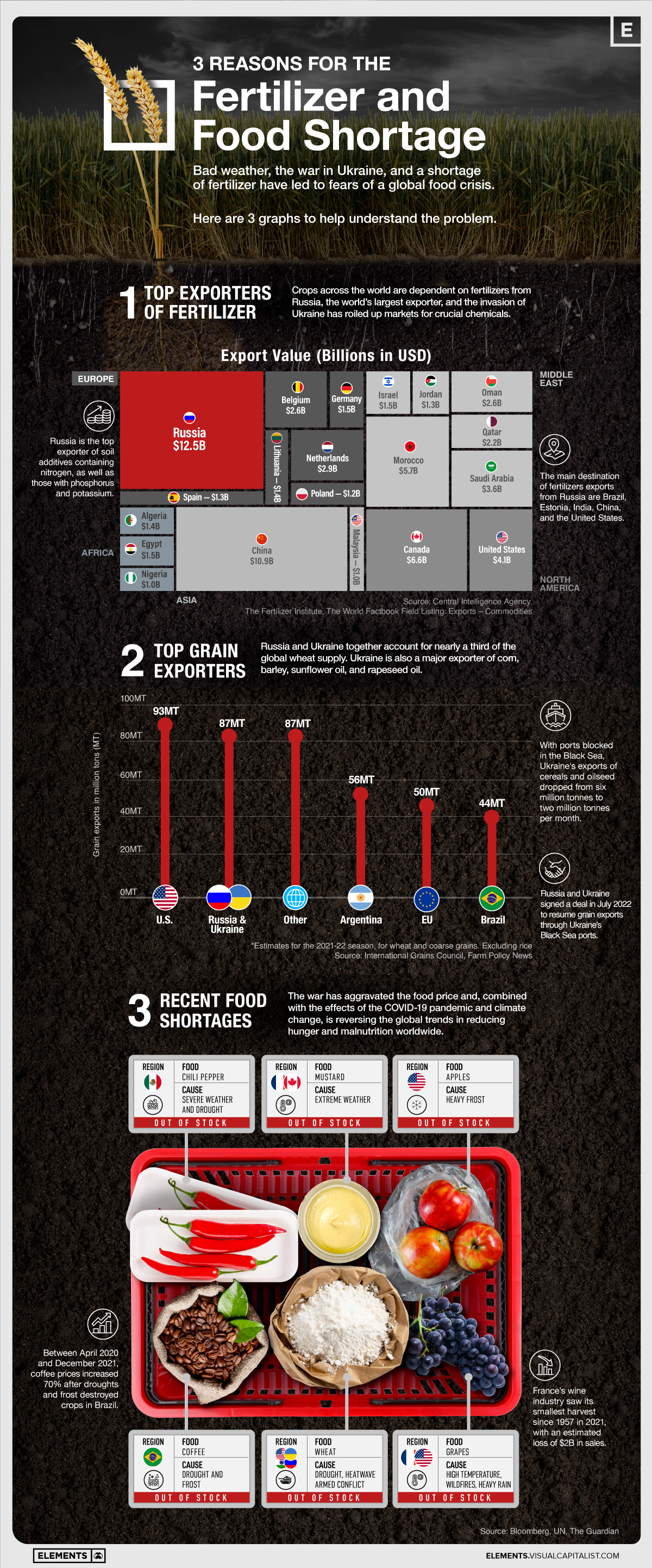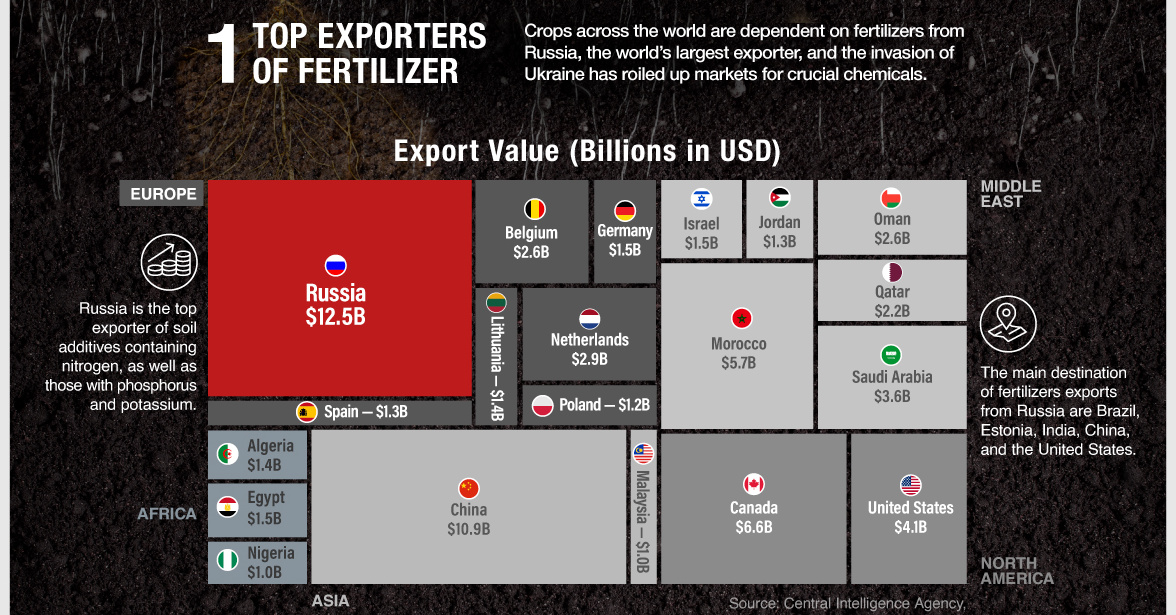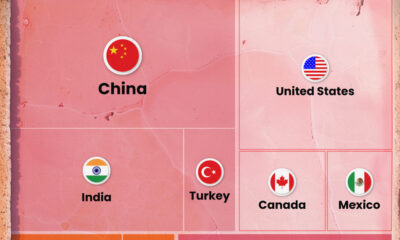Markets
3 Reasons for the Fertilizer and Food Shortage
![]() Subscribe to the Elements free mailing list for more like this
Subscribe to the Elements free mailing list for more like this

3 Reasons for the Fertilizer and Food Shortage
This was originally posted on Elements. Sign up to the free mailing list to get beautiful visualizations on natural resource megatrends in your email every week.
Bad weather, the Russian invasion of Ukraine, and a shortage of fertilizer have led to fears of a global food crisis.
This infographic will help you understand the problem by highlighting three key factors behind the mounting food crisis.
#1: The Fertilizer Shortage
Since the beginning of the Russian invasion of Ukraine in February 2022, the war has disrupted shipments of fertilizer, an essential source of nutrients for crops.
Russia is the world’s top exporter of nitrogen fertilizer and ranks second in phosphorus and potassium fertilizer exports. Belarus, a Russian ally also contending with Western sanctions, is another major fertilizer producer. In addition, both countries collectively account for over 40% of global exports of the crop nutrient potash.
Here are the top 20 fertilizer exporters globally:
| Rank | Country | Exports Value (Billions in USD) |
|---|---|---|
| #1 | 🇷🇺 Russia | $12.5 |
| #2 | 🇨🇳 China | $10.9 |
| #3 | 🇨🇦 Canada | $6.6 |
| #4 | 🇲🇦 Morocco | $5.7 |
| #5 | 🇺🇸 United States | $4.1 |
| #6 | 🇸🇦 Saudi Arabia | $3.6 |
| #7 | 🇳🇱 Netherlands | $2.9 |
| #8 | 🇧🇪 Belgium | $2.6 |
| #9 | 🇴🇲 Oman | $2.6 |
| #10 | 🇶🇦 Qatar | $2.2 |
| #11 | 🇩🇪 Germany | $1.5 |
| #12 | 🇮🇱I srael | $1.5 |
| #13 | 🇪🇬 Egypt | $1.5 |
| #14 | 🇱🇹 Lithuania | $1.4 |
| #15 | 🇩🇿 Algeria | $1.4 |
| #16 | 🇪🇸 Spain | $1.3 |
| #17 | 🇯🇴 Jordan | $1.3 |
| #18 | 🇵🇱 Poland | $1.2 |
| #19 | 🇲🇾 Malaysia | $1.0 |
| #20 | 🇳🇬 Nigeria | $1.0 |
The main destination of fertilizer exports from Russia are large economies like India, Brazil, China, and the United States.
However, many developing countries—including Mongolia, Honduras, Cameroon, Ghana, Senegal, and Guatemala—rely on Russia for at least one-fifth of their fertilizer imports.
Furthermore, the war intensified trends that were already disrupting supply, such as increased hoarding by major producing nations like China and sharp jumps in the price of natural gas, a key feedstock for fertilizer production.
#2: Global Grain Exports
The blockade of Ukrainian ports by Russia’s Black Sea fleet, along with Western sanctions against Russia, has worsened global supply chain bottlenecks, causing inflation in food and energy prices around the world.
This is largely because Russia and Ukraine together account for nearly one-third of the global wheat supply. Wheat is one of the most-used crops in the world annually, used to make a variety of food products like bread and pasta. Additionally, Ukraine is also a major exporter of corn, barley, sunflower oil, and rapeseed oil.
| Producer | Grain Exports in Million Tons (MT) |
|---|---|
| 🇺🇸 United States | 93MT |
| 🇷🇺 Russia & 🇺🇦 Ukraine | 87MT |
| 🇦🇷 Argentina | 56MT |
| 🇪🇺 EU | 50MT |
| 🇧🇷 Brazil | 44MT |
| Other | 87MT |
As a result of the blockade, Ukraine’s exports of cereals and oilseed dropped from six million tonnes to two million tonnes per month. After two months of negotiations, the two countries signed a deal to reopen Ukrainian Black Sea ports for grain exports, raising hopes that the international food crisis can be eased.
#3: Recent Food Shortages
Besides the war in Ukraine, factors including the COVID-19 pandemic and climate change resulted in nearly one billion people going hungry last year, according to United Nations.
France’s wine industry saw its smallest harvest since 1957 in 2021, with an estimated loss of $2 billion in sales due to increasingly higher temperatures and extreme weather conditions.
Heat, drought, and floods also decimated crops in Latin America, North America, and India in recent months. Between April 2020 and December 2021, coffee prices increased 70% after droughts and frost destroyed crops in Brazil.
In the face of multiple crises, the World Bank recently announced financial support of up to $30 billion to existing and new projects in areas such as agriculture, nutrition, social protection, water, and irrigation.
Maps
Mapped: The 10 U.S. States With the Lowest Real GDP Growth
In this graphic, we show where real GDP lagged the most across America in 2023 as high interest rates weighed on state economies.

The Top 10 U.S. States, by Lowest Real GDP Growth
This was originally posted on our Voronoi app. Download the app for free on iOS or Android and discover incredible data-driven charts from a variety of trusted sources.
While the U.S. economy defied expectations in 2023, posting 2.5% in real GDP growth, several states lagged behind.
Last year, oil-producing states led the pack in terms of real GDP growth across America, while the lowest growth was seen in states that were more sensitive to the impact of high interest rates, particularly due to slowdowns in the manufacturing and finance sectors.
This graphic shows the 10 states with the least robust real GDP growth in 2023, based on data from the Bureau of Economic Analysis.
Weakest State Economies in 2023
Below, we show the states with the slowest economic activity in inflation-adjusted terms, using chained 2017 dollars:
| Rank | State | Real GDP Growth 2023 YoY | Real GDP 2023 |
|---|---|---|---|
| 1 | Delaware | -1.2% | $74B |
| 2 | Wisconsin | +0.2% | $337B |
| 3 | New York | +0.7% | $1.8T |
| 4 | Missississippi | +0.7% | $115B |
| 5 | Georgia | +0.8% | $661B |
| 6 | Minnesota | +1.2% | $384B |
| 7 | New Hampshire | +1.2% | $91B |
| 8 | Ohio | +1.2% | $698B |
| 9 | Iowa | +1.3% | $200B |
| 10 | Illinois | +1.3% | $876B |
| U.S. | +2.5% | $22.4T |
Delaware witnessed the slowest growth in the country, with real GDP growth of -1.2% over the year as a sluggish finance and insurance sector dampened the state’s economy.
Like Delaware, the Midwestern state of Wisconsin also experienced declines across the finance and insurance sector, in addition to steep drops in the agriculture and manufacturing industries.
America’s third-biggest economy, New York, grew just 0.7% in 2023, falling far below the U.S. average. High interest rates took a toll on key sectors, with notable slowdowns in the construction and manufacturing sectors. In addition, falling home prices and a weaker job market contributed to slower economic growth.
Meanwhile, Georgia experienced the fifth-lowest real GDP growth rate. In March 2024, Rivian paused plans to build a $5 billion EV factory in Georgia, which was set to be one of the biggest economic development initiatives in the state in history.
These delays are likely to exacerbate setbacks for the state, however, both Kia and Hyundai have made significant investments in the EV industry, which could help boost Georgia’s manufacturing sector looking ahead.
-

 United States7 days ago
United States7 days agoMapped: Countries Where Recreational Cannabis is Legal
-

 Healthcare2 weeks ago
Healthcare2 weeks agoLife Expectancy by Region (1950-2050F)
-

 Markets2 weeks ago
Markets2 weeks agoThe Growth of a $1,000 Equity Investment, by Stock Market
-

 Markets2 weeks ago
Markets2 weeks agoMapped: Europe’s GDP Per Capita, by Country
-

 Money2 weeks ago
Money2 weeks agoCharted: What Frustrates Americans About the Tax System
-

 Technology2 weeks ago
Technology2 weeks agoCountries With the Highest Rates of Crypto Ownership
-

 Mining2 weeks ago
Mining2 weeks agoWhere the World’s Aluminum is Smelted, by Country
-

 Personal Finance2 weeks ago
Personal Finance2 weeks agoVisualizing the Tax Burden of Every U.S. State













